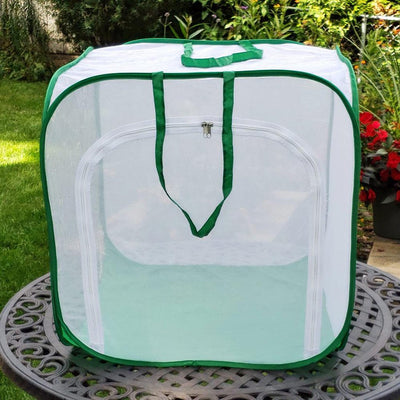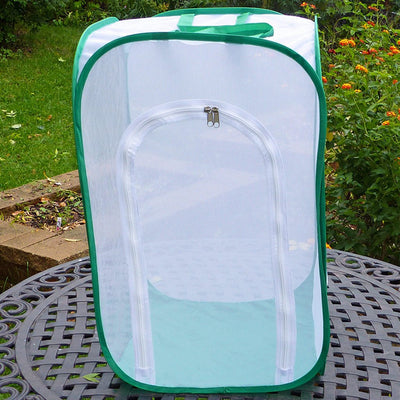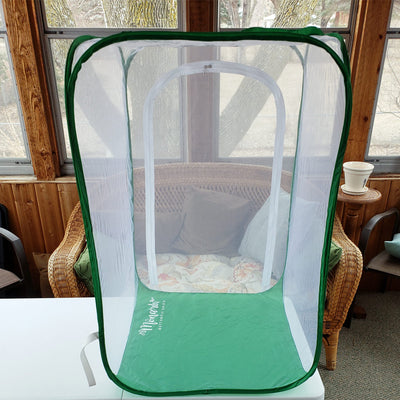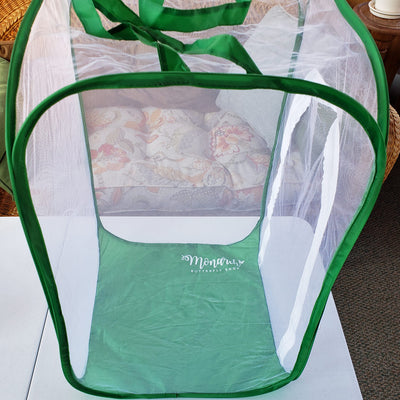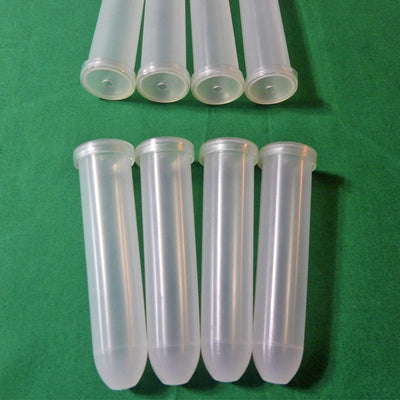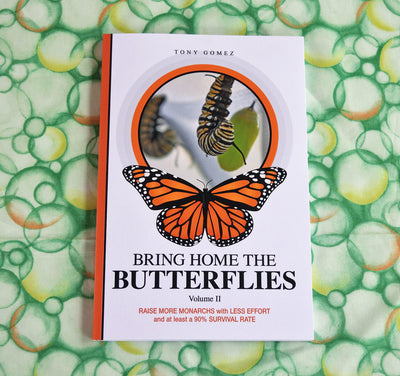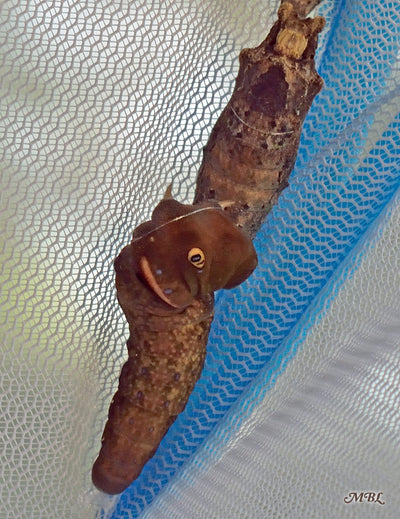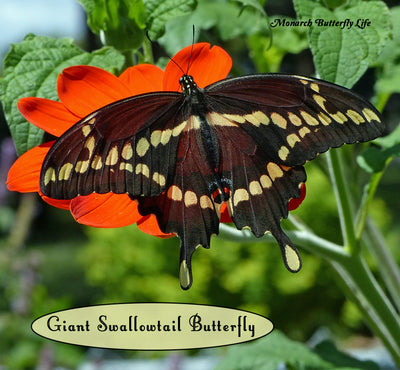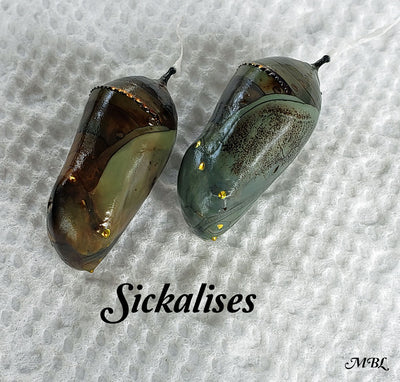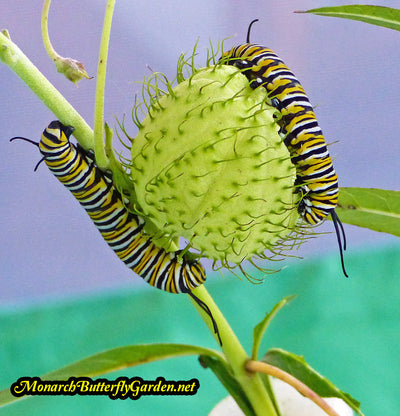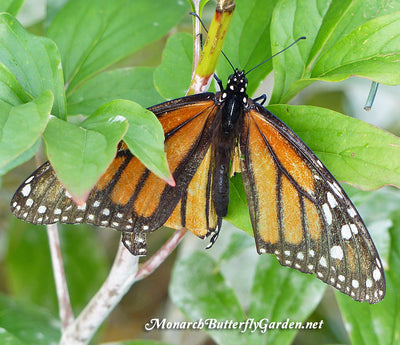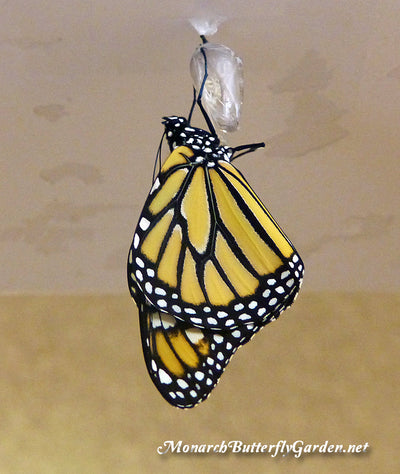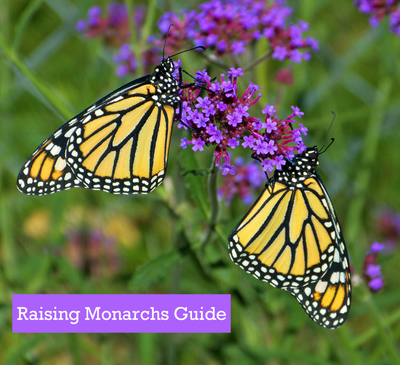Raising Butterflies Blog
How to Hunt, Gather, and Protect Monarch Eggs- Raising Monarchs Instructions
How to Hunt, Gather, and Protect your Monarch Eggs- Instructions for Stage 1 of the Monarch Butterfly Life Cycle

Welcome back to Raise the Migration. If you’ve gotten everything you need from the supply list, and prepared your milkweed for eggs, you’re ready to embark on a hunt to find monarch eggs in your garden or nearby milkweed patch…or perhaps you just received eggs from a suggested vendor?!
First we’ll hunt, then we’ll gather, and finally we’ll find a safe place for your monarch eggs to rest and develop until hatching…

Hunt For Eggs
Where should you look for monarch butterfly eggs? Here’s a list of places where many monarch raisers are finding their migration generation eggs:
 🐰-Munching Survivor w/ Monarch Egg + ONE MORE Underneath!
🐰-Munching Survivor w/ Monarch Egg + ONE MORE Underneath! Fresh Milkweed Seedling in August
Fresh Milkweed Seedling in AugustFemale monarch butterflies lay eggs on host plant milkweed so look for:
- Small milkweed seedlings that have popped up over the summer
- Rabbit-ravaged plants (with fresh growth)
- Lone milkweed plants located away from large patches that are crawling with predators…potted or garden plants
- Late season fresh-leaved milkweed varieties including tropical milkweed, balloon plant, swamp milkweed
- First year perennial milkweed seedlings w/ fresh leaves including common, swamp, butterfly weed
- Milkweed in partial shade to shade typically has fewer predators and the plant leaves stay fresh longer with breaks from the sultry summer ☀️
- Underside of milkweed leaves
- Buds of milkweed including tropical and giant milkweed
- Seed pods
- Nearby non-milkweed plant leaves or blades of grass…accidents happen! 🙃
- You can also find caterpillars on the lowest sets of leaves. When you all-of-the-sudden see a large 🐛 on your previously ‘unoccupied’ milkweed, that’s probably where it was hiding out.
 Hidden in Plain Sight
Hidden in Plain SightOf course, monarch females are the queens of egg-hiding, so leave no milkweed leaf unturned!
Search Tip: The glare of the bright sun can make eggs harder to see, so try searching in overcast conditions when the cream-colored eggs contrast better against green milkweed plants. In sunny weather, wear 😎
A big thanks to community member Robert W. for reminding me that monarchs aren’t the only mamas that lay eggs on milkweed. Here are some close-up monarch egg photos for those who aren’t quite sure what they’re looking for. Notice that monarch eggs have distinct ridges:
 WANTED
WANTED easy to find on red buds...thanks mama!
easy to find on red buds...thanks mama!Monarchs typically lay one single egg per leaf, but in late summer (August and September) it’s possible to find leaves with 2, 3…or even more! Many times they will be deposited from multiple monarchs, as the population size is peaking for the year.
If you have a hard time seeing small monarch eggs, try using a magnifying glass to confirm your findings.
Gather Your Eggs
 Ready for Eggs-tion
Ready for Eggs-tionThis is how we started collecting eggs (almost exclusively) in 2017 because it works no matter how you plan to raise your caterpillars after they hatch…
- Use a bowl or bucket to place any eggs you collect. Make sure this container is deep enough so leaves/eggs won’t blow away.
- If you find an egg on a leaf, cut off the entire leaf (with pruning snips) where the leaf petiole attaches to the milkweed stalk to remove the entire leaf, without disturbing the rest of the plant.
- If the egg is on the stalk or flower bud, use your pruning snips to cut off a small piece off the plant.
Once the eggs are inside, you have a couple options…
- Put a dry paper towel in the bottom of a large food container (excessively wet paper towels can cause monarch-killing mold)
- Use a container large enough container to space out several whole leaves. We use 16" x 11" x 3.5"h containers to hold up to 10 monarch eggs and wee cats 🐛 (Put less eggs in smaller containers)
- Take each leaf and gently rinse it under a faucet to rinse off potential sap-sucking pests like aphids, predators, viruses and pathogens.
4. Place each leaf egg-side up on the paper towel.

note: while some poke small air holes in the lid, this is not necessary. There will be more than enough oxygen in the container from your daily checks. 🔍 No holes will also prevent any potential baby caterpillar escapes.
OR
 Keeps Eggs on FRESH Milkweed
Keeps Eggs on FRESH MilkweedUse whole milkweed leaf cuttings of swamp/common/tropical/giant in florist tubes. Rinse each leaf thoroughly with water, but be careful not to wash away the egg. They are usually stuck like glue to the leaf.
Keep in mind, leaf petioles are short so you will need to make some leaf adjustments to eliminate the need for daily floral tube refilling…
Tip: Cut leaf away from both sides of the midrib to submerge the leaf further inside the tube for less refilling. In the photo above, I was able to submerge the leaf stem half way down the floral tube by cutting away the leaf.
When cutting around the midrib, it’s easiest to do this from the underside of the leaf where the midrib sticks out:

Submerging the midrib 1/3 to 1/2 way down the tube will suffice as one leaf will not absorb much water compared to a stem cutting. This method eliminates having to transfer baby caterpillars to a fresh milkweed leaf after hatching:

Find Floral Tubes (and rack) for Milkweed Cuttings Here
Why Not Bring in Eggs on Stem Cuttings or Plants?
- Hard to Keep Track of Monarch Eggs and Baby Caterpillars
- If any eggs have been parasitized by wasps, you might not notice them after they turn dark
- It’s harder to clean stem cuttings (and especially plants) thoroughly
If you find the perfect cutting and want to skip the single-leaf step, that’s definitely an option too:

However, hatching them in food containers or on single leaf cuttings will make it easier to keep track of your newborn caterpillars 🐛 🐛 🐛 🔍
Protect Your Eggs
You can keep these mini-greenhouse hatcheries (food containers) almost anywhere, but don’t place them in direct sun. 🌞 🍳 😱
If your eggs are indoors in a mesh cage, I would suggest temps of at least 73°F during the day to avoid slowing down metamorphosis.
I keep our mesh cages in a 3-season porch, where the windows are left open most of the season so it doesn’t get too stuffy. This exposes the developing monarchs to natural levels of heat and humidity, without exposing them to extreme conditions like wind and soaking rains.
The monarchs need environmental cues so they know it’s time to migrate. If your only option is raising indoors, raise by a window for natural lighting and open it whenever possible.
Our porched eggs and caterpillars get adequate light, but they’re not in all-day sun and I always make sure the PVC viewing window on our mesh cages is turned away from direct sunlight so it can’t sizzle our cage guests…we actually had a chrysalis that started melting from this! 🔎🔥🐛
During the 🐶 days of summer, we bring cages indoors if the temp goes over 100°F. If the overnight low is below 50° F we will do the same…how come?
Cold temperatures slow down metamorphosis. This can be a serious issue around the fall migration because October butterflies need to leave before it gets too cold to take flight.
Don’t put your eggs in a cage where there are already butterflies or chrysalises about to hatch. Adult butterflies can spread disease spores on to the milkweed below, and your baby caterpillars will ingest them. This can potentially disfigure them and/or produce sickly butterflies.
Water for Eggs?
Mesh Cages– Mist the milkweed leaves daily (water from a spray bottle) while you wait for your eggs to hatch. Just a couple quick sprays of water each morning will keep the eggs hydrated and can also wash away potential disease spores.
Sealed Food Containers– these hold in more moisture so mist only if it looks like the leaves are starting to dry out. On average, I spray the leaves inside the food container once before the monarch larvae hatch.
Now we wait for your cream-colored eggs to darken, signaling the impending birth of your baby monarch caterpillars and the larval stage…
I hope this info helps you with finding and caring for monarch eggs. For further assistance raising healthy butterflies through the monarch life cycle, our ✬✬✬✬✬ rated How To Raise More Monarchs, with Less Effort book is available for purchase HERE <<< (choose paperback or PDF download)

